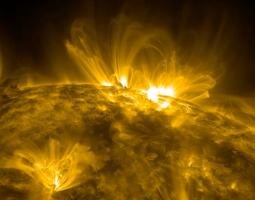What drives the changes in near-Earth space, the planetary space environments, and the heliosphere?
Space is not empty. The space surrounding Earth, the space between the planets, the space between the stars are far different from the environment we regularly experience on Earth – but it is far from calm. Our missions show that energy, charged particles, and magnetic fields course through space. It's a complex system in which electric currents generate magnetic fields and vice versa, while space radiation flows along in giant winds and particles can accelerate almost up to the speed of light. Input from the sun, cosmic rays from outside the solar system, Earth's magnetic fields and even terrestrial weather can cause additional change in the system.
By combining observations of near-Earth space and the space environment throughout our solar system with increasingly sophisticated computer simulations, NASA heliophysics research focuses on mapping out the details of our space environment.
Understanding the forces that drive change in our space environment not only helps us protect technology and astronauts from radiation, it also helps us understand what makes any given planet habitable. It takes more than just the right distance from a star for a planet to incubate life. The star's interaction with the planet's atmosphere and electromagnetic system can make all the difference between a planet that's too dry, too hot, or too radiation-filled versus one where life could take root.
NASA heliophysics missions that observe space near Earth, around the planets, and even beyond the sun's atmosphere include: the Van Allen Probes, the Magnetospheric Multiscale mission, Aeronomy of Ice in the Mesosphere, the Acceleration, Reconnection, Turbulence and Electrodynamics of the Moon’s Interaction with the Sun, Geotail, the Interstellar Boundary Explorer, the Time History of Events and Macroscale Interactions during Substorms mission, the Thermosphere, Ionosphere, Mesosphere Energetics and Dynamics mission, the Two Wide-angle Imaging Neutral-atom Spectrometers, Voyager, and Wind.




